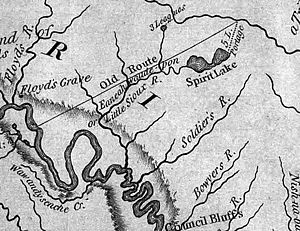Floyd River facts for kids
Quick facts for kids Floyd River |
|
|---|---|

This excerpt from the Lewis and Clark map of 1814 shows the rivers of western Iowa. The Floyd is seen at the upper left of the map.
|
|
| Country | United States |
| State | Iowa |
| District | Woodbury County, Iowa, Plymouth County, Iowa, Sioux County, Iowa, O'Brien County, Iowa |
| Physical characteristics | |
| Main source | 43°14′31″N 95°37′16″W / 43.242°N 95.621°W |
| River mouth | Missouri River 1,079 ft (329 m) 42°28′59″N 96°23′31″W / 42.483°N 96.392°W |
The Floyd River is a river in northwestern Iowa, United States. It flows for about 112 miles (180 km) before joining the much larger Missouri River in Sioux City. This river is special because it's named after Charles Floyd, who was an important member of the famous Lewis and Clark Expedition.
Contents
The River's Journey
The Floyd River begins in northwestern O'Brien County, near the town of Sanborn. From there, it generally flows southwest. It passes through Sioux, Plymouth, and Woodbury counties. Along its path, it goes by towns like Sheldon, Le Mars, and Hinton.
Near Merrill, the Floyd River gets bigger. This is where its largest branch, called the West Branch Floyd River, joins it. The West Branch is about 40 miles (65 km) long. It starts near Boyden and flows south through towns like Maurice. Finally, the Floyd River reaches Sioux City and flows into the Missouri River.
Flooding and River Control
The Floyd River has caused serious floods many times. Major floods happened in Sioux City in 1892 and 1953. To stop future disasters, a big flood control project was started.
Engineers have changed the lower part of the river in Sioux City. They made the river channel straighter and lined its banks with riprap (loose rocks). They also built high earthen walls called levees. These changes help control the water and protect the city from floods.
River Health Concerns
Sometimes, many fish in the Floyd River die. This is often caused by runoff from nearby farms. Runoff happens when rain washes animal waste from farm feedlots into the river. This pollution can harm the fish and other river life.
Who Was Charles Floyd?
The Floyd River is named after Charles Floyd. He was a U.S. Army sergeant from Kentucky. Charles Floyd was one of the first people to join the famous Lewis and Clark Expedition. This journey explored the western parts of the United States.
On August 19, 1804, just three months into the expedition, Charles Floyd became very sick. He died the next day. It is believed he died from a serious medical problem called a ruptured appendix. He was buried on a hill overlooking an unnamed river in Iowa.
To honor him, the expedition leaders, Meriwether Lewis and William Clark, named the river the Floyd River. They also named the hill where he was buried Floyd's Bluff. Charles Floyd was the only person to die during the entire two-year Lewis and Clark Expedition. This was despite the many dangers they faced traveling 8,000 miles to the Pacific Ocean and back to St. Louis.
Gallery
-
The Floyd River near Le Mars, Iowa
-
A channelized section of the Floyd River in Sioux City, just above its mouth at the Missouri River




